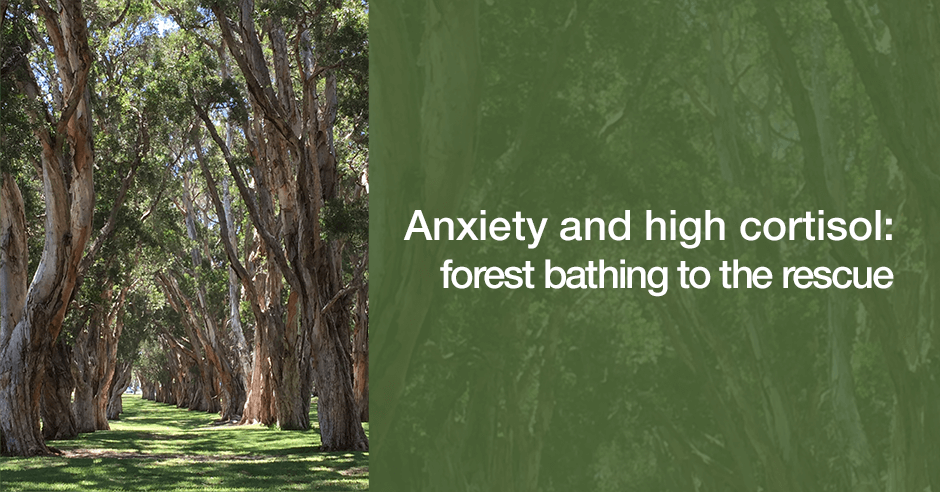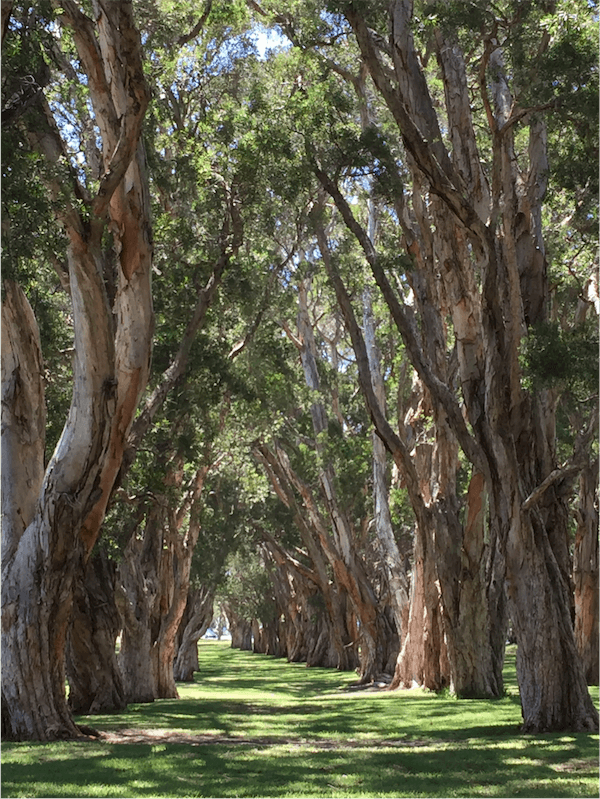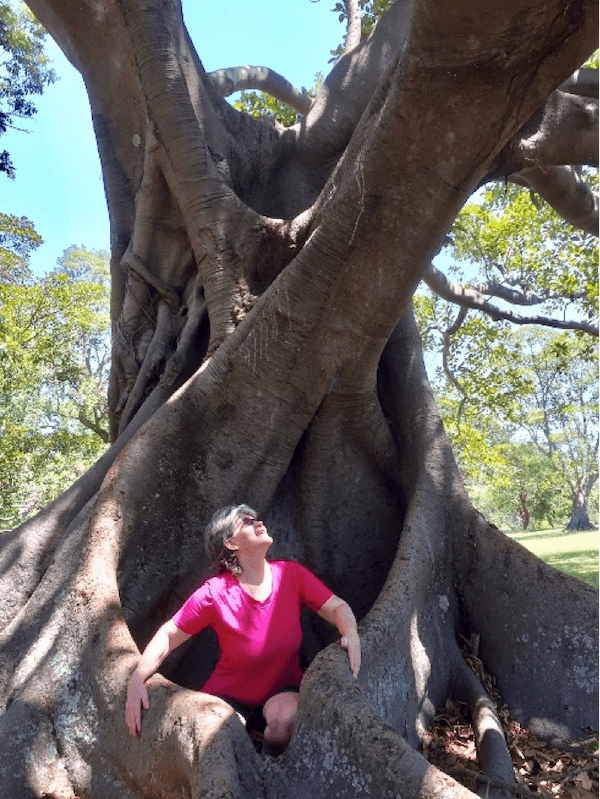
On the way home from a snorkelling trip to the beach earlier this week we stopped at Centennial Park in Sydney and were wowed by the magnificent trees. It inspired me to write this blog about forest bathing to inspire you to think about the power of nature as a simple way to give you joy and contribute to a wonderful sense of calm and peace. I was quite giddy with these feelings while there and still feel waves of awe days later when thinking about it and looking at these pictures of the Paperbark Grove and the massive Morton Bay fig trees.
We know being in nature has a psychological impact making us feel calm and relaxed, happy and joyful, and even playful. But what exactly is forest bathing and are there really physiological impacts i.e. does forest bathing simply help you feel good or does it actually lower your cortisol levels or blood pressure?
This paper, The physiological effects of Shinrin-yoku (taking in the forest atmosphere or forest bathing): evidence from field experiments in 24 forests across Japan, defines forest bathing:
The term Shinrin-yoku (taking in the forest atmosphere or forest bathing) was coined by the Japanese Ministry of Agriculture, Forestry, and Fisheries in 1982. It can be defined as making contact with and taking in the atmosphere of the forest: a process intended to improve an individual’s state of mental and physical relaxation
The above study set out to measure and clarify the physiological effects of Shinrin-yoku or forest bathing with 12 young male university students who had no history of physical or psychiatric disorders:
12 subjects walked in and viewed a forest or city area. On the first day, six subjects were sent to a forest area, and the others to a city area. On the second day, each group was sent to the other area as a cross-check.
The participants sat and viewed the landscape for 12-16 minutes and then walked in the landscape for 14-18 minutes (in one of the 24 forests and then in one of the 24 city areas on the second day).
The subjects had the following markers measured before breakfast and both before and after the walking and viewing periods:
- salivary cortisol
- blood pressure
- pulse rate and
- heart rate variability
After this surprisingly short period of viewing and walking in the forests the following results were found:
forest bathing promotes lower concentrations of cortisol, lower pulse rate, lower blood pressure, greater parasympathetic nerve activity, and lower sympathetic nerve activity
So, what we have, is more activity of the parasympathetic system i.e. more of the calming “rest and digest” activity and less activity of the sympathetic system i.e. what we term as “fight or flight” or stress activity.
The authors suggest that forest bathing “may be used as a strategy for preventive medicine” and I wholeheartedly agree.
Given that GABA can lower high pressure and calm down the “fight or flight” sympathetic system (see this animal study) I won’t be surprised when we see research showing us that forest bathing boosts GABA levels just in a similar way that yoga boosts GABA.
If you don’t have everyday access to parks, trees or forests be sure to go out of your way to make detours down nearby tree-lined streets to get some of these wonderful health benefits.
And because we know that simply looking at images of greenery and nature can have a calming and stress-reducing effect, here is a bigger version of the photo I took of the Paperbark Grove for you to enjoy looking at!

We were so excited to “discover” this gem and got home and googled it only to find out it’s a popular avenue for wedding parties! I’m sure you can see why!
Right next to the Paperbark Grove are three giant Moreton Bay fig trees. These trees are estimated to be older that the park, which was opened in 1888.

If you’re local to Sydney or come for a visit one day, I highly recommend a trip to Centennial Park to see these magnificent trees and do your own Australian version of forest bathing. You may just see me there!
Until then, I encourage you to get outside into forests, get “hugged” by trees, hug trees and gaze up and enjoy every calming and joyous moment. It can help to lower your cortisol levels so you can be free of anxiety and it may even help to prevent anxiety!
Please do share your favorite forest bathing locations and how they make you feel.
Do you think this works when the leaves are absent/not green?
Bonnie
We do know from research that greenery has a special health benefit but it can be done in winter when there are no leaves or they are not green. This article from the Association of Nature and Forest Therapy may give you some ideas https://www.anft.blog/blog/winter-forest-bathing. For me just being in nature is special and winter time with snow is extra special especially seeing the evergreens covered in snow. It does take a bit of practice to learn how to dress accordingly in layers but it opens up a whole new world.
Trudy, as usual.. you are a breath of fresh air. The trees and I thank you for all your devotion to this work! oxoxo Shivan
Shivan
Love the comment and the very obvious connection of “a breath of fresh air” to being out in nature forest bathing 🙂
Thank you for your devotion to educating and advocating for SIBO patients. And of course stress reduction is key for anyone with digestive issues so I hope you and your community get to do plenty of forest bathing!
My list of proven health benefits to getting out in nature keeps growing:
* increasing diversity of microbiome (per Zach Bush MD), just getting out in nature and breathing, as the air has microbes floating in it
* Trees and plants give off essential oils, and oxygen, more goodness to breathe in
* Sunlight – a necessary nutrient for our bodies. There are 5 bioactive types of light, I read about them in a book on Red & Infra-red light. Red & NIR light penetrate several inches into body and there is a list of the ways they benefit the body and bring on healing.
* This blog by Trudy, sharing the effect on cortisol, bp, stress, anxiety.
I get busy and tend to feel like spending time in the great outdoors is recreational and I don’t make time for it. Science/Health tidbits inspire me to change that. Thank you!!
C Sinclair
I love this response from you! Thank you! I’m like you and am inspired by the science and mechanisms
Hi Trudy,
My mom took an antibiotic after getting the flu almost a year ago. She has tried Meds, ECT treatment, and now tms with no alleviation of anxiety or depression. She can’t even finish her sentences sometimes and has been out of work. Do you have any recommendations ? My family is desperate for answers and have found nothing that will make her well. Is there any way you would be able to make room for an appointment for her. I am out of ideas. Thanks!
Sherri
I’m really sorry to hear about your mom. With the antibiotics I’d focus on gut health and the microbiome first, together with trials of the respective amino acids to try and get some relief while digging deeper. Please sign up for the waiting list here and we’ll be in touch https://www.everywomanover29.com/services.html
Hi Trudi van i use Gaba together with Nuzak. I only use it for three days. I olso have a stomabag. Will it effect the stamabag. I am suffering from depression due to a big operation that i have about 8 months ago. Thank you.
Jane
I have had clients use GABA with Nuzak (Fluoxetine) and there are no known contraindications. I have not had anyone with a stoma bag use GABA but don’t expect it to be a problem especially if it’s used sublingually and doesn’t go through the digestive system.
Thank you for all the sharing you do Trudy ! It is truly healthy and uplifting and very helpful !
Peggy Best
Peggy
Thanks for the lovely feedback and being part of this community!
Hi Trudy, I always enjoy reading your blogs and have learned a lot, but this one has really touched me, as I am looking after my sick husband I don’t get out a lot but have a lovely garden and my stress relief is pottering around in the garden or just sitting and looking at the beautiful flowers. I live in Australia on the Southern Highlands not far from Sydney and can relate to your blog. Thank you, I also have your book and taking GABA which helps a little and Natrol 5-HTP
Ursula
So glad to hear this one touched you and that you get stress relief and joy out of your garden (glad to hear GABA and 5-HTP helps to)
I’m sorry to hear about your husband. I’m sure you share some of your garden joy with him by bringing flowers inside and hopefully getting him out in the garden too. If that’s not possible a forest poster for him to look at and essential oils (if tolerated) are also so beneficial.
Dear Trudy,
Many Thanks from the heart for all the generous info you have shared on this site.
For some reason, I got to this precious material about the Thyroid &Hypothyroid only now and I’m so sad.
I’ve read today all that I possibly could for hours already, however, I missed the Summit that was many years ago with so many knowns and trusted doctors including you.
There is any chance in the world to see it again?
What would you suggest instead?
With much appreciation & gratitude,
Nadia Sasson
PS I’m a subscriber of your daily emails & much-appreciated articles, however, I missed great life-saving info as well.
Nadia
I’m not sure which summit you are referring to?